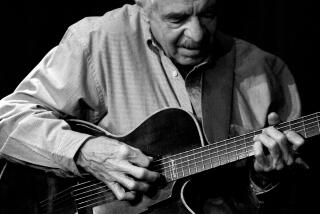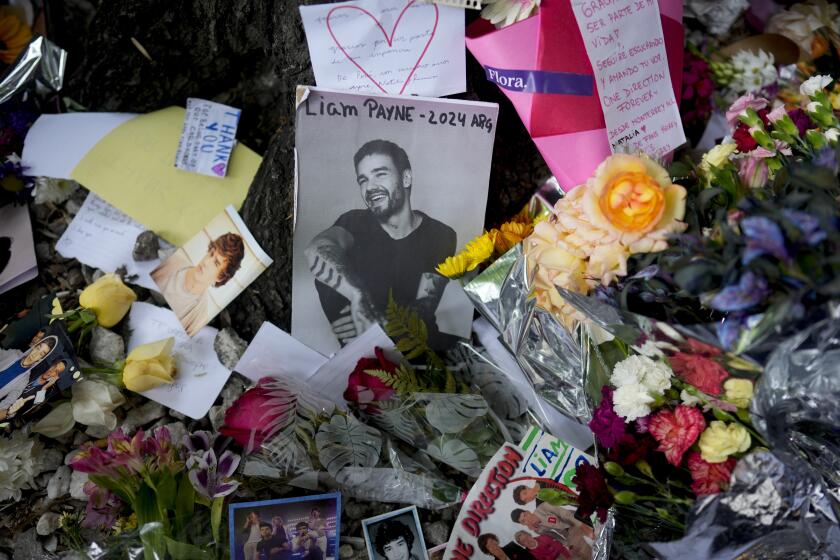Lovano, Sloane and Moody Do Sinatra Songs Their Way
- Share via
Frank Sinatra has always appealed to jazz musicians. The attraction traces, in part, to his long history of associating himself with the finest players, from his early days with Harry James and Tommy Dorsey to his final performance years, when his backup band was a virtual all-star ensemble.
But there were other fascinations, as well. Sinatra’s macho, lady-killer image also rang a bell with jazz players, many of whom have held on to their chauvinistic attitudes well into the present. Perhaps most important, however, was Sinatra’s implicit respect for the music--a quality particularly intrinsic to jazz, an art in which the true encounter is not between player and audience, but between the player and the music. Even today, with Sinatra in poor health, his influence upon the music scene continues. Two weeks ago, he was once again nominated for a Grammy Award (singing a duet version of “My Way” with Luciano Pavarotti).
So it’s not surprising that a performer such as Joe Lovano, who has demonstrated a consistently determined desire to measure his skills against a wide range of creative environments, would choose to do an album celebrating Sinatra. But the result is a curiously ambivalent performance. More than half the tracks are devoted to texturally lush arrangements by Manny Albam featuring woodwinds, strings and the soprano voice of Lovano’s wife, Judi Silvano. Albam is an extraordinary arranger who was particularly active with jazz artists in the ‘50s and ‘60s, and his ability to create gorgeous instrumental densities is beyond question.
But too often the settings, despite some fine playing from Lovano, sound studied rather than supportive. Instead of creating the kind of ambience that made songs such as “One for My Baby,” “All the Way” and “I’ve Got You Under y Skin” into Sinatra classics, they come across as distractions. If the intent was to recall the lush, moody aura of such Sinatra albums as “In the Wee Small Hours,” it falls well short.
Fortunately, the album also includes a few tracks in which Lovano works in the open, either with the first-rank rhythm section of pianist Kenny Werner, bassist George Mraz and drummer Al Foster or, in the case of a romping tour through “Chicago,” with Foster alone, and in the jaunty “South of the Border,” with Foster and Mraz. Those numbers, in addition to a smoothly lyrical “Imagination,” a grooving “This Love of Mine” and a high-speed “The Song Is You,” are superb--showcase proof that Lovano, when he is focused, is capable of some very mighty playing.
Leave it to Carole Sloane, who has been singing professionally for nearly 50 years, to bring understanding and compassion to her program of Sinatra tunes. Her readings, backed by a solid ensemble featuring tenor saxophonist Frank Wess and trombonist Steve Turre, don’t quite get inside tunes such as “Fly Me to the Moon,” “You Make Me Feel So Young” and “Young at Heart” in the way Sinatra does. But Sloane’s warm voice and easy, swinging phrasing are close enough.
James Moody doing Sinatra is a completely different matter. Give Moody a saxophone and a Sinatra tune, and there’s no argument about his ability to make magic. But singing? Well, Moody himself would be the last person to compare his crackly, jazzman’s tone to Sinatra’s, yet his readings have a captivating interpretive charm. In their own, unique way--supplemented, of course, by Moody’s always attractive saxophone--they come unexpectedly close to the essence of Ol’ Blue Eyes.
*
Albums are rated on a scale of one star (poor), two stars (fair), three stars (good) and four stars (excellent).
More to Read
The biggest entertainment stories
Get our big stories about Hollywood, film, television, music, arts, culture and more right in your inbox as soon as they publish.
You may occasionally receive promotional content from the Los Angeles Times.










